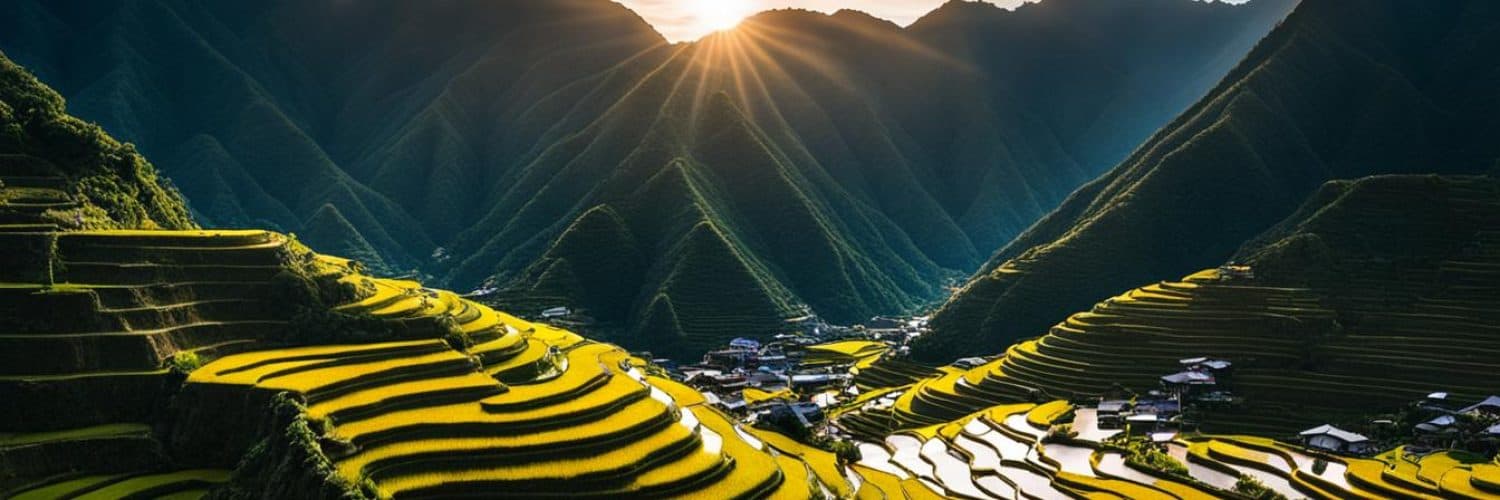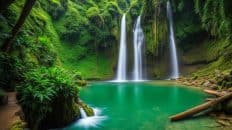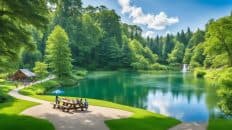Welcome to our comprehensive guide to the stunning Batad Rice Terraces, a UNESCO World Heritage Site located in the Ifugao province of the Philippines. This agricultural marvel showcases the rich cultural heritage of the Ifugao people and their sustainable approach to rice farming. Immerse yourself in the scenic beauty of terraced landscapes that have stood the test of time, and discover the unique charm of Ifugao culture.
Key Takeaways:
- Explore the stunning Batad Rice Terraces, a UNESCO World Heritage Site in Ifugao, Philippines.
- Experience the scenic beauty and breathtaking landscapes of this agricultural marvel.
- Immerse yourself in the rich cultural heritage of the Ifugao people.
- Learn about sustainable agriculture practices in rice farming.
- Discover the beauty and history of the Batad Rice Terraces during your visit to the Ifugao province.
How to Get to Batad
To experience the breathtaking beauty of Batad, you will first need to travel to Banaue, a town located in the Ifugao province of the Philippines. From Banaue, you have several transportation options to reach the village of Batad.
- Public Jeepney: One of the most common modes of transportation is a public jeepney. These colorful and iconic vehicles are a popular choice among locals and tourists alike. You can catch a public jeepney from Banaue to the nearest accessible point known as the Saddle.
- Private Vehicle: Another option is to hire a private vehicle, such as a jeep, to take you to the Saddle. This gives you more flexibility in terms of timing and comfort.
Once you reach the Saddle, you will embark on a thrilling 20-minute hike down muddy trails to reach the picturesque village of Batad.
Pro Tip: If you’re up for a challenge and enjoy trekking, you can choose to trek from Batad Junction. Be prepared for a strenuous uphill climb, but the panoramic views along the way are truly worth it!
During your journey, you may also come across tricycles, which are motorized vehicles with sidecars. These are often used for shorter distances or to carry heavier loads.
Getting to Batad
| Transportation Options | Pros | Cons |
|---|---|---|
| Public Jeepney | Accessible and affordable | May be crowded and have fixed schedules |
| Private Vehicle | Flexible and comfortable | Higher cost |
| Trekking | Scenic views and adventure | Physically demanding |
| Tricycle | Convenient for shorter distances | May not be suitable for all terrain |
Whichever mode of transportation you choose, the journey to Batad is an unforgettable experience, surrounded by the beauty of nature and the charm of the Ifugao region.
Where to Stay in Batad
When visiting Batad, there are several accommodation options that cater to different preferences. Whether you’re looking for a rustic homestay or a comfortable guesthouse, you’ll find a place to suit your needs.
Ramon’s Native Homestay
If you’re seeking an authentic experience, Ramon’s Native Homestay is an excellent choice. They offer unique native Ifugao huts that immerse you in the local culture. Wake up to stunning views of the rice terraces and enjoy the warm hospitality of the Ifugao people.
Ramon’s Homestay
Ramon’s Homestay also provides regular rooms for those who prefer a more conventional accommodation option. These rooms offer comfort and convenience, allowing you to relax after a day of exploring the magnificent Batad Rice Terraces.
Awa View Deck Accommodations
If you wish to stay near the popular Awa View Deck, there are other accommodations available in the area. These options provide easy access to breathtaking panoramic views of the rice terraces, allowing you to soak in the beauty of Batad at your leisure.
It’s important to note that Batad is a popular destination, especially during peak travel seasons. Therefore, it is advisable to book your accommodation in advance to secure your preferred option.
Entrance Fees and Environmental Fees
When planning a visit to the breathtaking Batad Rice Terraces, it’s important to be aware of the entrance fees and environmental fees associated with preserving this UNESCO World Heritage Site. These fees not only help maintain the beauty of the rice terraces but also support the local community and sustainable tourism efforts.
Visitors are required to pay an environmental fee of PHP 20 per person at the Banaue tourism office, which is the gateway to Batad. This fee contributes to the preservation and conservation of the iconic rice terraces, ensuring future generations can continue to enjoy their scenic beauty.
Upon entering Batad village, there is an additional environmental fee of PHP 50 per person. This fee goes directly towards the maintenance and upkeep of the village, including the trails, infrastructure, and community projects. It is important to note that these fees are subject to change, so it’s advisable to check with the Banaue tourism office for the most up-to-date information.
Tourism Fees at a Glance:
| Fee Description | Amount (PHP) |
|---|---|
| Environmental Fee at Banaue Tourism Office | 20 |
| Environmental Fee upon entering Batad Village | 50 |
It’s important to come prepared by bringing enough cash with you, as there are no ATMs available in Banaue or Batad. By paying these fees, you are not only gaining access to a truly remarkable destination but also contributing to its preservation and the sustainable development of the local community.
Best Time to Visit Batad
The beauty of Batad Rice Terraces varies throughout the year, offering different experiences for visitors. The lush greenery of the terraces is at its peak from April to May and October to November, making these the best times to visit Batad.
During these months, the rice terraces are at their most vibrant and picturesque, providing breathtaking views that will leave you in awe. The pleasant weather makes it enjoyable to explore and immerse yourself in the stunning landscapes of Batad.
However, it is important to note that Batad can be visited all year round, with each season offering its own unique charm. Here is a breakdown of the different seasons and what you can expect:
- Hot and Dry Season (March to May): This season offers sunny and warm days, making it ideal for outdoor activities. The rice terraces may not be as green as in the wet season, but the clear skies provide excellent visibility and allow you to fully appreciate the intricate farming system.
- Rainy Season (June to September): The rainy season brings lush greenery to the terraces, creating a breathtaking sight. While it may rain frequently, the showers are often short-lived, and you can still enjoy the beauty of the rice terraces between rain showers.
- Cool and Dry Season (November to February): This season offers cool and pleasant weather, making it a popular time for travelers. The terraces may not be as green as in the wet season, but the cooler temperatures make hiking and exploring more comfortable.
Ultimately, the best time to visit Batad depends on your preferences and what you want to experience. Whether you’re captivated by the vibrant green terraces or intrigued by the farming practices, Batad has something to offer in every season.
| Season | Weather | Rice Terrace Appearance | Recommended Activities |
|---|---|---|---|
| Hot and Dry Season (March to May) | Sunny and warm | Not as green as in the wet season | Outdoor activities, cultural immersion |
| Rainy Season (June to September) | Frequent rain showers | Lush greenery | Hiking, enjoying the natural beauty |
| Cool and Dry Season (November to February) | Cool and pleasant | Not as green as in the wet season | Hiking, exploring, cultural activities |
Whichever season you choose to visit Batad, you can be sure to witness the awe-inspiring beauty of the rice terraces and immerse yourself in the rich culture of the Ifugao people.
Things to Do in Batad
When visiting Batad, there are plenty of exciting activities to keep you engaged and immersed in the beauty of this enchanting destination. From natural wonders to cultural experiences, here are some of the top things to do in Batad:
Trek to Tappiya Waterfalls
Embark on a scenic trek to Tappiya Waterfalls, a mesmerizing natural wonder located just an hour away from Batad. As you navigate through lush greenery and rocky paths, you’ll be rewarded with breathtaking views of the cascading falls. Take a refreshing dip in the cool waters or simply bask in the awe-inspiring beauty of the surroundings.
Hike to Awa View Deck
For panoramic vistas of the iconic Batad rice terraces, head to Awa View Deck. This hiking trail offers stunning views that extend as far as the eye can see, showcasing the intricate beauty of the terraced landscapes. Capture awe-inspiring photographs or simply soak in the mesmerizing scenery while appreciating the grandeur of nature.
Explore Batad Village
Immerse yourself in the rich Ifugao culture by exploring the charming Batad Village. Wander through its picturesque streets lined with traditional huts and witness the daily lives of the locals. Engage in conversation with the friendly residents, learn about their customs and traditions, and gain a deeper appreciation for the fascinating heritage of the Ifugao people.
Batad Village Trek
Embark on a trek through the captivating Batad Village, where you can witness the terraced fields up close and learn about the intricate rice-farming techniques of the Ifugao people. Traverse through the winding trails, marvel at the agricultural marvel that has sustained generations, and gain a deeper understanding of the sustainable agricultural practices that have shaped this UNESCO World Heritage Site.
Ifugao Cultural Experience
Engage in an authentic Ifugao cultural experience by participating in traditional activities such as bamboo weaving, wood carving, or learning traditional dances. Interact with locals and gain insight into their daily lives, customs, and rituals. This immersive encounter will leave you with a profound appreciation for the vibrant and thriving Ifugao culture.
“Batad offers a myriad of activities that allow travelers to truly connect with nature and the local culture. Whether you’re marveling at the beauty of Tappiya Waterfalls, capturing Instagram-worthy shots at Awa View Deck, exploring the charming Batad Village, embarking on a trek through the terraced fields, or immersing yourself in Ifugao culture, every experience in Batad is sure to leave you with unforgettable memories.”
Sample Itinerary for Batad
Planning a trip to Batad? Here’s a sample 2-day itinerary to help you make the most of your visit to this picturesque destination:
-
Day 1: Arrival and Village Exploration
Arrive in Banaue and make your way to Batad, the village where the breathtaking rice terraces are located. Spend the afternoon exploring the village, immersing yourself in the local culture, and soaking in the stunning views of the terraces. Take your time to appreciate the beauty of this UNESCO World Heritage Site.
-
Day 2: Tappiya Waterfalls and Awa View Deck
Start your second day with an invigorating hike to Tappiya Waterfalls. Marvel at the cascading waters and lush surroundings of this natural wonder. Afterward, head to Awa View Deck, where you’ll be treated to panoramic views of the rice terraces, providing a perfect opportunity for photos and reflection.
-
Day 3: Departure
On your final day, bid farewell to the enchanting Batad and make your way back to Banaue or your next destination. Cherish the memories and the beauty you’ve experienced, taking with you the essence of Ifugao culture and the awe-inspiring landscapes of the rice terraces.
Remember, this sample itinerary can be customized based on your personal preferences and available time. Whether you’re a nature lover, a cultural enthusiast, or simply seeking a tranquil escape, Batad has something to offer everyone.
Explore the scenic beauty of Batad’s rice terraces with this sample itinerary. Immerse yourself in the local culture, marvel at the Tappiya Waterfalls, and capture breathtaking views from Awa View Deck.
Budget and Expenses in Batad
When planning a trip to Batad, it’s essential to consider your budget and expenses. The total cost of your trip will depend on several factors, including your choice of accommodation, transportation options, and the activities you plan to engage in.
For budget travelers, Batad offers affordable accommodations and transportation options. You can find guesthouses and homestays that provide comfortable yet budget-friendly stays. These accommodations offer a great opportunity to immerse yourself in the local culture and interact with friendly locals. Additionally, public transportation, such as jeepneys and tricycles, is available for cost-effective travel within Batad and its surrounding areas.
On the other hand, if you’re looking for a more luxurious experience, you can choose to stay in upscale guesthouses or resorts that offer premium amenities and services. These accommodations provide a higher level of comfort and convenience, allowing you to relax and indulge in your surroundings.
It is important to note that there are limited ATM options in Batad, so it is recommended to have enough cash on hand to cover your expenses. It’s also advisable to carry small bills and change, as some establishments may not be able to provide exact change for larger denominations.
To help you estimate your expenses, here’s a breakdown of typical costs in Batad:
| Expense | Estimated Cost |
|---|---|
| Accommodation in Batad | Varies (PHP 500 – PHP 3000 per night) |
| Transportation to Batad | Varies (PHP 1000 – PHP 3000 round trip) |
| Meals and Drinks | Varies (PHP 200 – PHP 500 per meal) |
| Entrance Fees | PHP 70 (Environmental Fee) |
| Guide Fees | Varies (PHP 500 – PHP 1000 per day) |
Please note that these costs are estimates and can vary depending on your preferences and the time of your visit. It’s recommended to research and plan your budget accordingly to ensure a smooth and enjoyable trip to Batad.
Conclusion
The Batad Rice Terraces in Ifugao, Philippines, are a spectacular UNESCO World Heritage Site that showcases the stunning landscapes and rich cultural heritage of the Ifugao people.
By trekking to Tappiya Waterfalls, visitors can witness the majestic beauty of the rice terraces up close. The Awa View Deck offers panoramic views that highlight the agricultural marvel of sustainable rice farming in the region. Immersing oneself in the local culture provides a deeper appreciation for the Ifugao way of life.
When planning a trip to the Batad Rice Terraces, tourists can expect to be awestruck by the scenic beauty and the significance of this cultural treasure. Exploring the terraces and gaining insight into the sustainable agricultural practices of the Ifugao people offers a unique and unforgettable experience.
FAQ
How do I get to Batad?
To get to Batad, you must first travel to Banaue. From there, you can take a public jeepney or hire a private vehicle to the closest accessible point, called the Saddle. From the Saddle, you will need to hike for about 20 minutes down muddy trails to reach the village of Batad. Alternatively, you can choose to trek from Batad Junction, but this involves a challenging uphill climb. Transportation options include public jeepneys, private jeeps, or tricycles.
Where can I stay in Batad?
Batad offers a few accommodation options for visitors, ranging from rustic homestays to guesthouses. One popular choice is Ramon’s Native Homestay, which offers unique native Ifugao huts for an authentic experience. Other options include regular rooms at Ramon’s Homestay and accommodations near Awa View Deck. It is recommended to book in advance, especially during peak travel seasons.
Are there entrance fees and environmental fees in Batad?
Yes, visitors to Batad are required to pay an environmental fee at the tourism office in Banaue. This fee is PHP 20 per person and helps support the preservation of the rice terraces. Additionally, there is an environmental fee of PHP 50 per person upon entering Batad village. It is important to bring enough cash with you as there are no ATMs in Banaue or Batad.
When is the best time to visit Batad?
The best time to visit Batad is between April and May, and then between October and November when the rice terraces are at their greenest. During these months, the terraces offer breathtaking views and the weather is pleasant. However, it is possible to visit Batad throughout the year, each season offering a unique perspective of the rice terraces.
What are some things to do in Batad?
There are several activities to enjoy in Batad, including a trek to Tappiya Waterfalls, which takes about an hour and offers beautiful views. Another must-do is hiking to Awa View Deck, which provides panoramic views of the Batad rice terraces. You can also explore Batad Village and immerse yourself in the rich Ifugao culture.
Can you provide a sample itinerary for Batad?
For a short visit to Batad, a sample itinerary could include arriving in Banaue on Day 1 and traveling to Batad. Spend the afternoon exploring the village and enjoying the views. On Day 2, hike to Tappiya Waterfalls in the morning and visit Awa View Deck in the afternoon. Depart from Batad on Day 3. This itinerary can be adjusted based on personal preferences and available time.
How much does a trip to Batad cost?
The total cost of a trip to Batad will depend on various factors, such as accommodation choices, transportation options, and activities. Budget travelers can find affordable accommodations and transportation options in Batad, while those looking for a more luxurious experience can choose to stay in upscale guesthouses. It is recommended to have enough cash on hand as there are limited ATM options in the area.
Source Links
- https://www.tripadvisor.com/Attraction_Review-g294249-d550273-Reviews-Batad_Rice_Terraces-Banaue_Ifugao_Province_Cordillera_Region_Luzon.html
- https://www.willflyforfood.net/the-first-timers-travel-guide-to-batad-rice-terraces-banaue-ifugao-philippines/
- https://www.laidbacktrip.com/posts/batad-and-banaue-guide


















Add comment